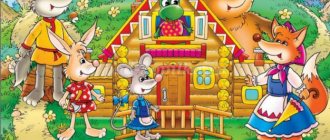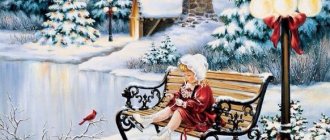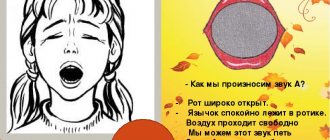Summary of a music lesson for preschoolers 3-5 years old
Summary of the musical lesson “Building a new tower”
Author: Daria Anatolyevna Pakhomova, teacher of folk singing, MBUDOD DSHI, Chegdomyn village, Khabarovsk Territory, Verkhnebureinsky district. Description of the material: This material will be useful to teachers of children's art schools, kindergarten teachers, and music directors of children's groups. Goal: formation of musical abilities. Objectives: • Recall the plot of the Russian folk tale “Teremok”; • Develop musical, rhythmic, dynamic hearing; • Reinforce the material covered (articulation exercises, songs, games) • Develop acting skills; • Develop memory, attention; • Develop articulation; • Arouse interest, awaken imagination; • Develop personal communication skills. Equipment: picture cards, musical instrument, picture puzzle, ball. Preliminary work: Making picture cards for exercises, picture puzzles, learning musical material with children (the song “Look how it is in our workshop”, the song-game “Tili-bom”), learning tongue twisters.
Progress of the lesson:
Teacher: Hello, guys! Remember from which fairy tale these words: “Who lives in a little house, who lives in a low one?” (Russian folk tale “Teremok”) That’s right, from the fairy tale “Teremok”! Now let’s learn the song about Teremok:
There is a mansion in a field It is neither low nor high Who lives in it Who will open the door for me? (Children are learning the song) Now try to guess my riddles about the heroes of the fairy tale “Teremok”: • Small stature, Long tail, Gray fur coat, Sharp teeth. (Mouse)
Let's imagine what she is like? (small, agile, curious...) Guys, try to sing the song from the perspective of the mouse (children sing, trying to intonationally and emotionally show how small, agile, curious the mouse is...) • Green, but not grass. Cold, but not ice. Sings, but not a bird - This is such a fable. (Frog)
As you know, frogs love to jump. Let's try to musically depict how a jumping frog sings this song (the teacher sings the song staccato - abruptly, the children repeat) • He was Russian, but the snow fell, His fluffy fur turned white, And he is invisible in winter to the Wolf and the red fox! (Hare)
And our bunny is very cowardly, his heart sinks into his heels (the teacher sings the song like this: sings the first line and claps his hands 4 times, explains to the children that the heart of a cowardly hare beats like this after each line of the song) • Protects his fluffy tail And guards the little animals: They know the red one in the forest is a very cunning one (fox)
The fox is a cunning, resourceful cheat, she has a beautiful fluffy tail, guys, let's show how the fox proudly walks around, showing off its tail and performing a song. (Children sing a song depicting the gait of a fox, its lazy gait, how it touches its tail, etc...) • Appearance of a dog, In a gray tailcoat, In the forest under the bushes Clicking its fangs. (wolf)
Guys, what kind of wolf is there in fairy tales? (angry, hungry, cruel, he can be both stupid (the fairy tale “The Fox and the Wolf”) and wise (the fairy tale “Ivan Tsarevich and the Gray Wolf”), etc...) And how does the wolf howl? Let's try to howl with you (children try both together and one by one) And now we'll sing our song and after each line we'll try to howl like a hungry gray wolf. • The owner of the forest wakes up in the spring, And in winter, to the howl of a blizzard, He sleeps in a snowy hut. (Bear)
The bear in fairy tales is kind, strong, capable of protecting the weak, finding justice, and the only right solution. But the problem is that he is so clumsy, because it was he who destroyed the tower. Show how a clubfooted bear walks. Well done! We will sing a song on behalf of the bear, we will sing and depict how he walks awkwardly and leisurely. Teacher: And now we will remember and repeat the tongue twisters about the heroes of this fairy tale:
(we pronounce each tongue twister 3 times at an average pace, make sure that we breathe properly and have clear diction) • The mouse washed the cones. There were too many cones. The mouse didn't clean up the cones. • The frog croaked a song in the frog's ear. • The hare stands with a scythe, mows the grass, carries hay. • In the forest, a fox under a pine tree made a bed for the little fox. • Wolves lived near the forest. The wolves howled loudly at night. • The bear growled in the den, His feet were frozen. Teacher: Well done, guys! Now let’s remember the plot of the fairy tale “Teremok”. I will ask you questions, and you try to answer correctly:
1. Where is the tower located? (in the field) 2. Who ran to the tower first? (mouse) 3. How tall is the tower? (not low, not high) 4. Who came to the house after the frog? (hare) 5. Who destroyed the mansion? (bear) 6. How many animals were gathered in the house when the bear came to them? (five) 7. Who was the first to be invited by the mouse to live in the little house? (frog) 8. Mouse-norushka, frog-frog, bunny-bunny, little fox-sister, what was the name of the wolf? (top - gray barrel) 9. Under what conditions were the animals ready to forgive the bear for his ridiculous act? (if the bear helps them build a new house) Teacher: Guys, let's help the fairy tale heroes build a new house so that there is enough space for everyone, even the bear? And without what can we not build a house? (children's answers) I'll tell you riddles:
• With an iron head he hits those whom he hits, he will hammer them into the floor and into the ceiling. A sharp nail... (hammer) • A very important tool. Will prepare firewood in no time. She has teeth: Sharp, not dull. They guessed that it was necessary - ... (Saw) • I am all made of iron, I have neither legs nor arms. I’ll fit up to my hat into the board, but for me there’s still a knock and a knock. (Nail) • It has knots and a nose like a shovel, It has a hunchbacked back. The yard is full of wood, what is his name? (Axe) • Earwig boasts - I like to dance. I'm friends with Screws and I'll spin anyone. "Look!" She started dancing and the screw got stuck in the board. (Screwdriver) • The measuring tape was twisted and placed in the case. It helps us to measure the length using marks... (tape tape) What are they called in one word? (tools) That's right, tools! Teacher: So what should our heroes build a house from? I will name the material, and the one to whom I throw the ball will name what the house will be like from this material (task for schoolchildren): From straw - straw; From stone... From wood... From metal... From glass... From iron... From brick... (For younger children, you can play a game like “edible things are not edible”; only on the contrary, you need to catch objects that are useful for construction, but don’t catch edible ones. For example : brick, apple, nail, screwdriver, cucumber, tomato, boards, etc...) Teacher: What do you think would be better to build a strong house from? (children's answers) And we will try to build a house in our own way. (articulation exercises)
To install the walls, take the “hammers” and knock.
• Exercise “Hammer”. Goal: preparing articulation for the sound [r] and vibration of the tip of the tongue. Methodical recommendations: tap your tongue and pronounce the sound [d]. Make sure that the tip of your tongue does not fall down or stick out of your mouth. Note: if a guttural sound is corrected, then the sound [t] is pronounced. Make sure that there is no nasal tint, the voice does not strain, and the lower jaw does not rise. Knock with the sound [d, t] 5-6 times. The tip of the tongue knocks at the top of the alveoli with the sound [d] or [t]. They made large, bright windows in the wall. Like these ones. • Exercise “Window”. Goal: to be able to hold the mouth open while simultaneously showing the upper and lower teeth. Methodical recommendations: slowly open your mouth. The teeth should be visible. Keep counting to 5. When the walls and ceiling were ready, the animals decided to paint them. Let's paint the ceiling. • Exercise “Painter”. Goal: to develop an upward movement of the wide front part of the tongue. Methodical instructions: Smile, open your mouth. Using the wide tip of your tongue, stroke the roof of your mouth from your teeth to your throat. The lower jaw should not move. Now let's paint the windows and walls. • Exercise “Painting the windows” - lick your lips; “Let’s paint the walls” - move your tongue inside your cheeks. We'll put a pipe like this on the roof of the house. • Exercise “Pipe” - stretch out your lips with a wide tube. Wash the floor. • Smile, open your mouth, and use the tip of your tongue to strongly “clean” behind your lower teeth. When the house was clean, they hung up beautiful “curtains.” Like these ones. • Exercise “Curtains” Goal: to be able to hold your mouth open while simultaneously showing the upper and lower teeth, activate the muscles of the tongue. Methodological instructions: smile, open your mouth wide, lift the tip of your tongue and place it behind the tubercles behind the upper teeth, hold in this position. Teacher: In which song that we were learning are instruments found? That's right, the song “Look how it is in our workshop”) Let's sing it!
Look how in our workshop, the workers there work day and day. As they begin to chop with a hatchet, - (children put their hands in a “lock” and show the movements of the chopping ax)
Use a hammer to hit the nails.
- (they tap on the palm with their fist)
And with saws they saw, saw, saw, -
(they put their hand forward and put it back - “staring”)
Sawdust is flying in all directions.
It's time for the carpenters to finish their work, so they go and dance in a squat: (the boys dance in a squat, the girls spin around)
Ay, lyuli, ah, lyuli, ah, lyuli, Ay, lyuli, yes, ah, lyuli, yes, ah, lyuli!
Ay, lyuli, ah, lyuli, ah, lyuli, Ay, lyuli, yes, ah, lyuli, yes, ah, lyuli! Teacher: Well done, you remembered the song! Now let's play the game "Tili-bom" .
Tili-bom, tili-bom We will build a new house! Dance to your heart's content Your legs are beautiful! 2 people are selected - this is the “Gate”, they stand facing each other, hold hands and raise them up (they get a gate). The rest of the children stand one after another and put their hands on the shoulders of the person walking in front or simply join hands. While singing the song, the resulting chain of children must pass under the gate. On the last syllable of the word “good,” the “collars” abruptly lower their hands, and those that are caught also become “collars.” Gradually the number of “gates” increases, and the chain decreases. The game ends when all children become "gates". (similar to the game “Golden Gate”) Teacher: Before you is a cut-up picture of our new Teremok, your task is to assemble the picture.
Teacher: What great fellows you are! You managed to build a new Teremok in which there was a place for everyone, both the little mouse and the big bear. Let's applaud each other! See you again!
We recommend watching:
Notes on music in the middle group “Birds in Spring” Notes on a music lesson in the middle group Development of musical and rhythmic skills in children of the 2nd junior group Musical entertainment in the middle group of a preschool educational institution. Scenario
Similar articles:
Musical role-playing game for children 3-4 years old
How to tell about notes?
Before you introduce your child to notes, you need to explain to him what they are.
Notes are recorded sounds. Just as we write our speech in letters, so music is written in notes. There are a huge variety of notes: both high and low, but they are all divided into 7 basic ones, which everyone knows: do, re, mi, fa, salt, la, si.
The notes live on a musical staff, which consists of 5 lines. The notes can be located either directly on these lines, or between them, they can also be under and above the lines, and on additional lines that we draw above or below.
Draw a staff of music on a large sheet of paper and write notes in a row on it (you can color them in different colors). Then sing them all together with your child.
To make your child interested in learning notes, you can show him a cartoon about the notes “Do Re Mi.”
A start has been made - the child has a general understanding of notes. Only after showing interest in notes can you start learning them seriously (it’s better to do this on another day).
How to remember notes and their location on the staff?
First, let's prepare everything we need:
- draw a large musical staff on a piece of paper;
- Let's cut out 7 oval notes the size of a 5-ruble coin.
It is advisable that the notes be colored, like the colors of the rainbow: this way they are better remembered.
Training should take place in several stages:
- First, we learn three notes located on the first three lines: mi, salt, si.
- When the child learns three notes and can identify them in different sequences, we begin to study the notes located between the lines: D, F, A.
- When the child masters both of them and is able to identify both interspersed, we learn the note “C” located on the additional line, and the “C” of the 2nd octave between the third and fourth line.
- After this, ask your child to make a scale of notes, starting with “C” of the 1st octave and ending with “C” of the 2nd octave.
- At the next stage, the child lays out simple melodies from notes, writes them out in an album and performs them on the piano. This stage is especially pleasant for him, because he plays the notes!
- After this, you can safely take children's music books and identify the notes there.
When the child already identifies all the notes well, you can move on to gradually learning everything else: keys, durations, pauses, octaves, etc.



